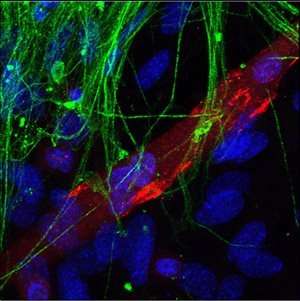New stem cell research uncovers causes of spinal muscular atrophy

New research from the Advanced Gene and Cell Therapy Lab at Royal Holloway, University of London has used pioneering stem cell techniques to better understand why certain cells are more at risk of degenerating in spinal muscular atrophy than others.
Spinal muscular atrophy is a devastating hereditary disease and is the biggest genetic killer in infancy.
Dr Rafael Yáñez and his team from the School of Biological Sciences used Induced Pluripotent Stem Cells (iPSCs) which are created by treating cells from a skin biopsy, a hair follicle – or almost any body part – with chemicals and genes in the lab. The iPSCs were then 'reprogrammed' and coerced into forming motor neurons, the cells from the spinal cord which control movement and breathing.
The researchers found that during the process of differentiation (when cells change from stem to their final shape) two key proteins change in a significant way in motor neurons, which could explain why these cells are more susceptible to degeneration in spinal muscular atrophy.
The findings can now be used for testing therapies in the Induced Pluripotent Stem Cells and motor neurons.
Dr Rafael Yáñez, said: "We have observed a progressive reduction of SMN and PLS3 proteins during differentiation of induced pluripotent stem cells to motor neurons, similar to some reports in animals and some controversial data from human development. These changes may underpin the susceptibility of motor neurons to spinal muscular atrophy. We now will investigate the reason for the changes, and more importantly, progress our research for novel therapies taking these protein changes into account. The research also shows how we are trying to reduce reliance on animal experiments whenever possible, as these stem cells now allow the production of human cells that cannot be obtained directly from patients and we can study the cells in lab dishes."
More information: "Decay in survival motor neuron and plastin 3 levels during differentiation of iPSC-derived human motor neurons" Scientific Reports 5, Article number: 11696 DOI: 10.1038/srep11696




















